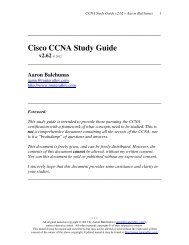Hubs vs. Switches vs. Routers - Router Alley
Hubs vs. Switches vs. Routers - Router Alley
Hubs vs. Switches vs. Routers - Router Alley
You also want an ePaper? Increase the reach of your titles
YUMPU automatically turns print PDFs into web optimized ePapers that Google loves.
Layer-3 Switching<br />
<strong>Hubs</strong> <strong>vs</strong>. <strong>Switches</strong> <strong>vs</strong>. <strong><strong>Router</strong>s</strong> v1.31 – Aaron Balchunas 10<br />
In addition to performing Layer-2 switching functions, a Layer-3 switch<br />
must also meet the following criteria:<br />
• The switch must be capable of making Layer-3 forwarding decisions<br />
(traditionally referred to as routing).<br />
• The switch must cache network traffic flows, so that Layer-3<br />
forwarding can occur in hardware.<br />
Many older modular switches support Layer-3 route processors – this alone<br />
does not qualify as Layer-3 switching. Layer-2 and Layer-3 processors can<br />
act independently within a single switch chassis, with each packet requiring<br />
a route-table lookup on the route processor.<br />
Layer-3 switches leverage ASICs to perform Layer-3 forwarding in<br />
hardware. For the first packet of a particular traffic flow, the Layer-3 switch<br />
will perform a standard route-table lookup. This flow is then cached in<br />
hardware – which preserves required routing information, such as the<br />
destination network and the MAC address of the corresponding next-hop.<br />
Subsequent packets of that flow will bypass the route-table lookup, and will<br />
be forwarded based on the cached information, reducing latency. This<br />
concept is known as route once, switch many.<br />
Layer-3 switches are predominantly used to route between VLANs:<br />
Traffic between devices within the same VLAN, such as ComputerA and<br />
ComputerB, is switched at Layer-2 as normal. The first packet between<br />
devices in different VLANs, such as ComputerA and ComputerD, is routed.<br />
The switch will then cache that IP traffic flow, and subsequent packets in<br />
that flow will be switched in hardware.<br />
* * *<br />
All original material copyright © 2011 by Aaron Balchunas (aaron@routeralley.com),<br />
unless otherwise noted. All other material copyright © of their respective owners.<br />
This material may be copied and used freely, but may not be altered or sold without the expressed written<br />
consent of the owner of the above copyright. Updated material may be found at http://www.routeralley.com.

















